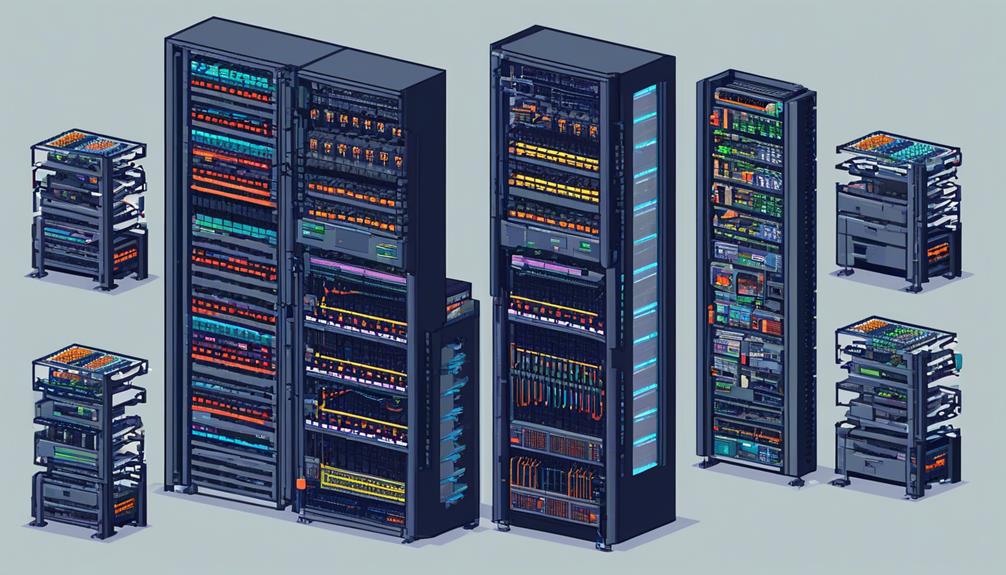In today's digital era, server racks play a critical role in the smooth functioning of businesses and organizations. These racks serve as the backbone of IT infrastructure, housing and organizing various servers, networking equipment, and storage devices.
However, the effectiveness of server racks heavily relies on the essential accessories and components that accompany them. From power and surge protection to cooling and ventilation systems, cable management solutions to security measures, and maintenance and upkeep, the world of server rack essentials is vast and complex.
In this discussion, we will delve into the importance of server racks, the types available, installation and mounting procedures, cable management solutions, cooling and ventilation systems, security measures, and maintenance strategies.
So, let's explore this fascinating world of server rack essentials and discover how they can enhance the performance and efficiency of your IT infrastructure.
Key Takeaways
- Server racks are essential for ensuring the availability and safety of server equipment.
- Blanking panels and ventilation fans help maintain proper airflow and prevent equipment performance issues due to overheating.
- Rack selection criteria should consider size, weight capacity, and airflow requirements.
- Proper cable management techniques and regular maintenance are important for a clean and organized server rack setup.
Importance of Server Racks
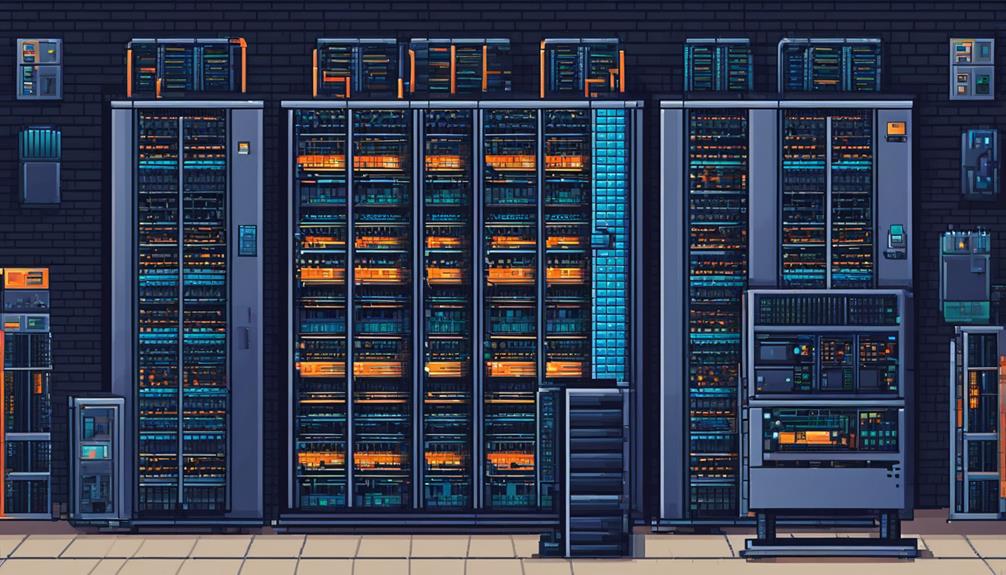
Why are server racks crucial for maintaining the availability and safety of server equipment?
The importance of server racks cannot be overstated when it comes to the smooth operation and protection of server equipment. Server rack essentials such as surge protection, cooling efficiency, and proper equipment installation are vital for ensuring the availability and safety of servers.
One of the primary reasons for using server racks is to provide surge protection. With 24/7 availability being a crucial requirement for server equipment, the risk of damage or fire caused by power surges must be minimized. Server racks offer surge protection mechanisms that shield the equipment from potential electrical disturbances, thereby reducing the risk of downtime and equipment failure.
Another essential aspect of server racks is their ability to manage airflow and maximize cooling efficiency. Blanking panels play a crucial role in this regard by separating cold and hot air, ensuring proper airflow maintenance within the rack. By managing airflow effectively, server racks prevent hot spots and maintain optimal temperatures, preventing equipment performance issues caused by overheating.
Furthermore, server rack ventilation fans contribute significantly to equipment safety and performance. These fans break up hot spots and improve ventilation, preventing high temperatures that can negatively impact server operation. Ventilation fans are particularly useful in empty spaces within the rack, where airflow may be restricted. By ensuring proper ventilation, server racks help maintain the longevity and reliability of the equipment.
Lastly, server racks facilitate proper equipment installation. The 4 post to 2 post rack adapter is an essential tool that enables safe and compatible installation of servers in a 2 post rack. This adapter provides a cost-effective solution for users with 2 post racks, ensuring that servers are securely and efficiently installed.
Types of Server Racks
There are various types of server racks available, each designed to meet specific requirements for equipment storage and organization. One essential type of server rack is the rackmount power strip with surge protection. This accessory helps protect equipment from power surges and ensures 24/7 availability.
Another important type is the server rack KVM (Keyboard, Video, Mouse), which offers a space-saving all-in-one solution for server control. It can be used with a KVM switch for multiple server video output.
To manage airflow and maximize cooling efficiency, blanking panels are used in server racks. These panels help keep cold and hot air separated, which is necessary for maintaining proper airflow in the rack. Another accessory that aids in ventilation is the server rack ventilation fan. This fan breaks up hot spots, improves ventilation, and prevents high temperatures that can affect equipment performance. It is particularly useful for empty spaces in the rack.
For those using a 2 post rack, a 4 post to 2 post rack adapter is a cost-effective solution. This adapter allows for safe and compatible installation of servers in a 2 post rack. It provides the necessary support and stability required for proper equipment storage.
Rack Mounting and Installation
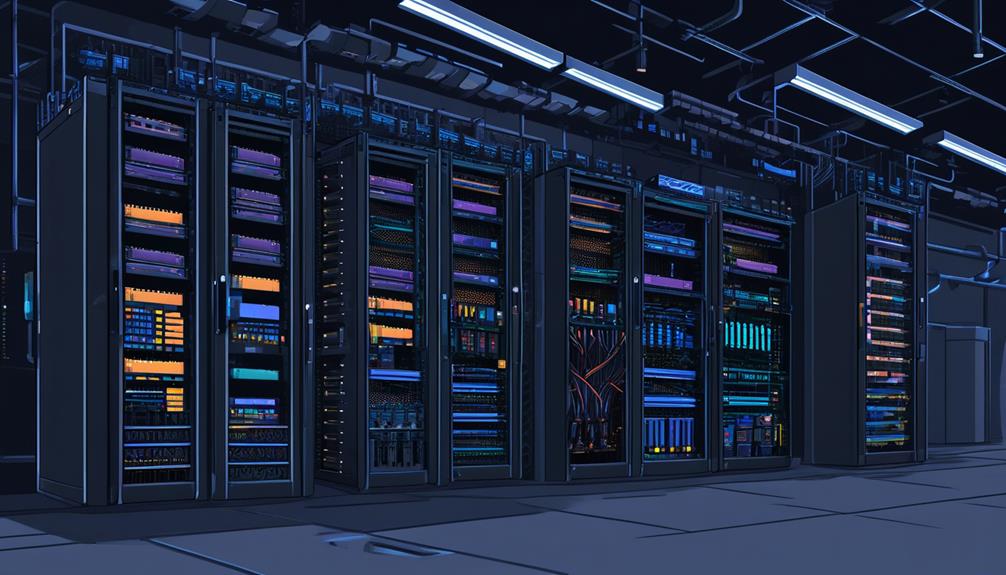
When it comes to rack mounting and installation, there are three key points to consider: rack selection criteria, mounting equipment securely, and cable management techniques.
Rack selection criteria involve choosing the right rack based on factors such as size, weight capacity, and airflow requirements.
Mounting equipment securely ensures that the servers and other components are properly installed and stable within the rack.
Lastly, cable management techniques help organize and route cables efficiently to maintain a clean and organized setup.
Rack Selection Criteria
To ensure a seamless and efficient installation process, careful consideration must be given to the rack selection criteria for mounting and installing server equipment. When choosing server racks, it is essential to evaluate the main frame and mounting options to ensure compatibility with the equipment.
Additionally, rack components such as a rackmount power strip with surge protection, server rack KVM fitting, blanking panels, and ventilation fans should be taken into account. A rackmount power strip with surge protection safeguards equipment from damage or fire.
A server rack KVM fitting provides a comprehensive solution for server control and video output. Blanking panels manage airflow and maintain proper airflow in the rack, while a server rack ventilation fan helps improve ventilation and prevent high temperatures that may affect equipment performance.
Lastly, a 4 post to 2 post rack adapter offers a safe and cost-effective solution for 2 post rack users.
Mounting Equipment Securely
Properly securing and installing server equipment in a rack is crucial for ensuring safety and preventing any potential damage. To achieve this, there are several key considerations to keep in mind:
- Rackmount power strips with surge protection: These accessories provide continuous power to the equipment while also safeguarding it against electrical surges. This helps protect critical data and prevent any potential damage caused by power fluctuations.
- Blanking panels: These panels serve the purpose of managing airflow within the rack. By covering unused spaces, they help maintain proper cooling efficiency, ensuring that the equipment doesn't overheat.
- Server rack ventilation fans: These fans play a vital role in enhancing ventilation within the rack. By improving airflow, they prevent the buildup of excessive heat, which could otherwise impact the performance of the equipment.
- 4 post to 2 post rack adapters: These adapters enable safe and compatible installation for different rack types. They provide flexibility in mounting equipment securely, regardless of the rack design.
Cable Management Techniques
Cable management techniques play a crucial role in ensuring efficient rack mounting and installation of server equipment. Implementing horizontal and vertical cable management bars helps organize and route cables within the server rack, preventing them from becoming tangled or obstructing airflow. To maximize cooling efficiency, blanking panels should be used to manage airflow and maintain proper airflow within the rack. Additionally, incorporating a server rack ventilation fan can help break up hot spots and improve ventilation, preventing high temperatures that can affect equipment performance. Another useful accessory is a server rack drawer, which provides convenient storage for commonly used maintenance tools. By utilizing these cable management techniques, rack power strips can be properly organized, ensuring a clean and organized server rack installation.
| Cable Management Techniques | Benefits |
|---|---|
| Horizontal cable management bars | Organizes and routes cables efficiently |
| Vertical cable management bars | Prevents cable tangling and obstruction of airflow |
| Blanking panels | Manages airflow and maintains proper airflow within the rack |
| Server rack ventilation fan | Breaks up hot spots and improves ventilation |
| Server rack drawer | Provides convenient storage for maintenance tools |
| Rack power strips | Ensures a clean and organized installation |
Cable Management Solutions
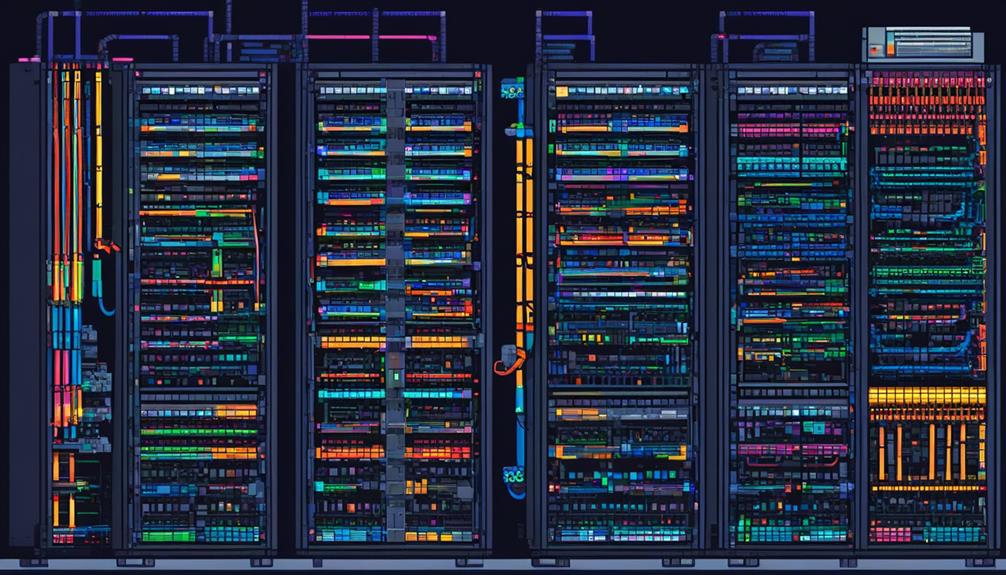
Cable management solutions play a crucial role in maintaining neat and organized cables within a server rack. These solutions offer various cable routing options, such as cable ties, clips, and rings, to ensure efficient organization and prevent tangling.
Additionally, labeling and identification techniques can be employed to facilitate easy identification and troubleshooting of cables within the rack.
Neat and Organized Cables
An efficient server rack setup relies on the implementation of cable management solutions to ensure the orderly arrangement and secure management of cables. To achieve a neat and organized cable setup, the following cable management solutions can be utilized:
- Cable management panels: These panels prevent cable tangling and enhance airflow, improving the overall efficiency of the system.
- Cable ties and clips: These accessories aid in neat and organized cable routing, contributing to a more structured setup.
- Cable management rings: These rings provide an easy solution for organizing cables within the server rack, further enhancing cable organization.
- Cable management accessories: These additional accessories, such as cable managers and cable trays, contribute to efficient cable management, aiding in maintaining an organized and structured cable setup within the server rack.
Cable Routing Options
Efficient cable routing options are crucial for the effective management and organization of cables within a server rack setup. Cable management bars play a significant role in routing cables to and from the equipment. Horizontal bars are used for routing cables, while vertical bars are utilized for organizing cables traveling up or down the rack.
Cable management solutions also include various panels, such as cable management panels, which prevent cable tangling and improve airflow. Blanking panels are available in different sizes and configurations to optimize cooling efficiency by preventing hot air recirculation and unnecessary equipment heating. HotLok Blanking Panels with Upsite Temperature Strip are particularly effective in sealing and optimizing airflow within server racks.
Additionally, server rack drawer accessories provide convenient storage for maintenance tools, further enhancing efficiency and organization in server rack maintenance.
Labeling and Identification
Labeling and identification solutions play a crucial role in organizing and efficiently maintaining cable management within a server rack setup. To ensure an organized and well-maintained server rack environment, the following cable management solutions are essential:
- Cable management bars: These bars help in organizing and routing cables both horizontally and vertically within the rack, preventing cable tangling and improving airflow.
- Blanking panels: These panels fill the empty spaces in the rack, preventing hot spots and ensuring proper airflow.
- Cable management accessories: Cable ties, clips, and rings aid in neat and organized cable routing, preventing tangles and improving airflow.
- Labeling and identification: Properly labeling and identifying cables and connections simplify maintenance and troubleshooting tasks, saving time and effort.
Implementing these cable management solutions in open frame racks ensures a well-organized and efficient server rack setup, minimizing cable management issues and promoting optimal performance.
Cooling and Ventilation Systems
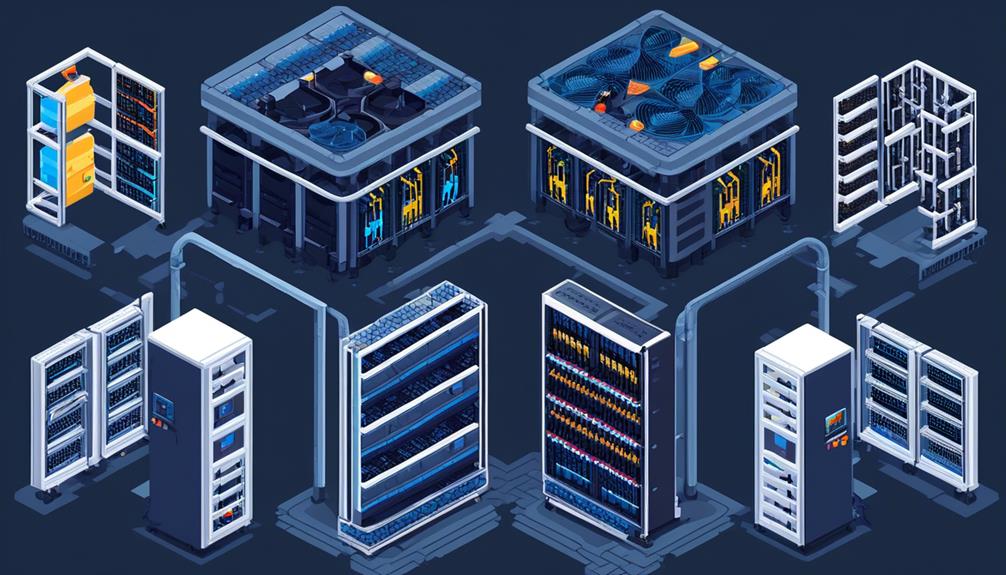
Proper management of airflow is essential for maintaining optimal cooling and ventilation in server racks. In the data center industry, cooling and ventilation systems play a crucial role in preventing overheating and preserving the performance of equipment.
Blanking panels are a vital component of these systems as they help manage airflow and maximize cooling efficiency. These panels are necessary to maintain proper airflow and ensure that cold and hot air remain separated within the rack.
By installing blanking panels, cold air is directed towards the equipment in the rack, while hot air is expelled efficiently. This separation ensures that hot spots are minimized, preventing any potential damage caused by high temperatures.
Additionally, server rack ventilation fans are employed to enhance ventilation and break up any hot spots that may occur. These fans play a significant role in maintaining a balanced temperature and preventing equipment performance issues.
Cooling and ventilation accessories are essential for preventing overheating and maintaining optimal conditions within the server rack. It is crucial to choose the right cooling solutions based on the specific requirements of the data center. Properly designed cooling systems not only prevent equipment failures but also contribute to energy efficiency.
Security Measures for Server Racks
To ensure the comprehensive protection of valuable equipment, implementing robust security measures is imperative within server rack environments. Safeguarding server racks not only prevents unauthorized access to sensitive data but also minimizes the risk of physical damage to the equipment.
Here are some essential security measures to consider:
- Restricted Access: Limiting access to authorized personnel is crucial for maintaining the security of server racks. Implementing physical barriers like locked doors or biometric access control systems can help prevent unauthorized individuals from accessing the equipment.
- Surveillance Systems: Installing security cameras in the server room can act as a deterrent for potential intruders. Additionally, recording footage can assist in identifying any security breaches or suspicious activities.
- Environmental Monitoring: Monitoring the server room environment is essential to prevent potential threats. Installing temperature and humidity sensors can help identify hot spots that might pose an increased risk of damaging the equipment. Additionally, smoke detectors can detect early signs of fire, allowing for prompt action to prevent any potential damage.
- Secure Rack Mounting: Properly securing the equipment within the server racks is crucial. Utilizing cage nut tools can ensure a secure and stable mounting, preventing any accidental dislodging of equipment. Additionally, cable management and organizing cables neatly can minimize the risk of tripping or accidentally disconnecting cables.
Maintenance and Upkeep of Server Racks
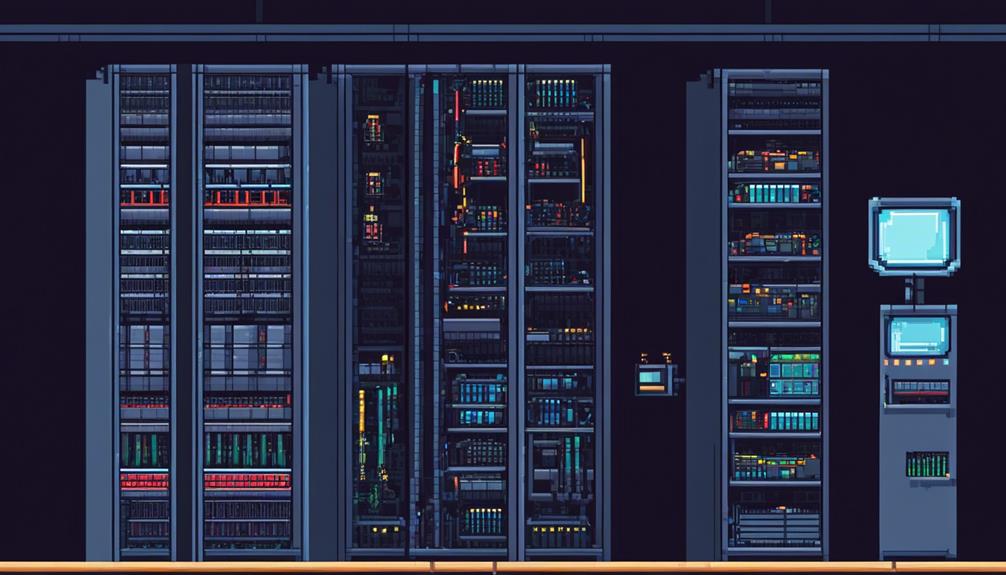
Maintaining the optimal functionality and longevity of server racks requires diligent maintenance and proper upkeep. In data centers, where server racks are essential components, several measures can be taken to ensure their smooth operation.
Firstly, the installation of a rackmount power strip with surge protection is crucial. This power strip provides continuous power to the equipment and reduces the risk of damage or fire caused by power surges. It is imperative to choose a power strip that is compatible with the rack and meets the necessary safety standards.
Secondly, the frame and mounting rails of the server rack should be regularly inspected and maintained. Any signs of damage or wear should be addressed promptly to prevent structural issues that could compromise the stability of the rack.
Furthermore, sliding shelves can be utilized to simplify maintenance tasks. These shelves allow easy access to the equipment within the rack, making it convenient to perform routine checks and replace components as needed.
Proper cable management is another crucial aspect of server rack maintenance. Cable management bars, both horizontal and vertical, should be used to organize and route cables effectively. This ensures that cables are neatly arranged, preventing tangling and facilitating airflow within the rack.
Lastly, regular cleaning and dust removal are essential maintenance tasks for server racks. Accumulated dust can hinder proper ventilation and cooling, leading to overheating and potential equipment failures. Regular cleaning with appropriate tools and techniques will help maintain optimal performance.
Frequently Asked Questions
What Is a Standard Server Rack With?
A standard server rack is an essential component in data centers and IT infrastructure. It provides a secure and organized space for mounting servers, networking equipment, and other hardware.
The advantages of using a server rack include improved airflow management, easier cable management, and enhanced physical security.
The installation process involves properly aligning and mounting the equipment in the rack, ensuring proper grounding and power distribution, and configuring the network connections.
Do You Need Rails for a Server Rack?
Yes, rails are essential for a server rack as they ensure rack compatibility and provide a standardized method for mounting servers.
While alternative rack mounting options exist, rails offer numerous benefits such as:
- Easy installation and removal of servers
- Stable and secure platform for heavy equipment
- Even weight distribution
- Improved airflow and cooling efficiency
However, common issues with server rack rails include:
- Compatibility issues
- Difficulty in installation
- Limited adjustability.
What Does a Server Rack Contain?
A server rack is an essential piece of equipment for organizing and housing servers and networking equipment. It provides several benefits, including improved accessibility, security, and space efficiency.
Different types of server rack configurations, such as open frame racks and enclosed cabinets, offer varying levels of protection and airflow management.
Proper cable management is crucial to ensure efficient operation and prevent cable damage or tangling.
Adequate cooling and airflow are also important considerations to maintain optimal performance and prevent overheating of equipment.
What Is Needed in a Server Rack?
Best practices for cable management in a server rack include using cable management panels, cable ties, and cable management arms to organize and route cables properly.
Cooling solutions for server racks involve using rack-mounted fans, air conditioning units, and proper airflow management with blanking panels.
Security measures for protecting server racks include using lockable doors and panels, security cameras, and access control systems.
Power distribution options for server racks include rackmount power distribution units (PDUs) and power management solutions to ensure reliable and efficient power delivery to the equipment.

